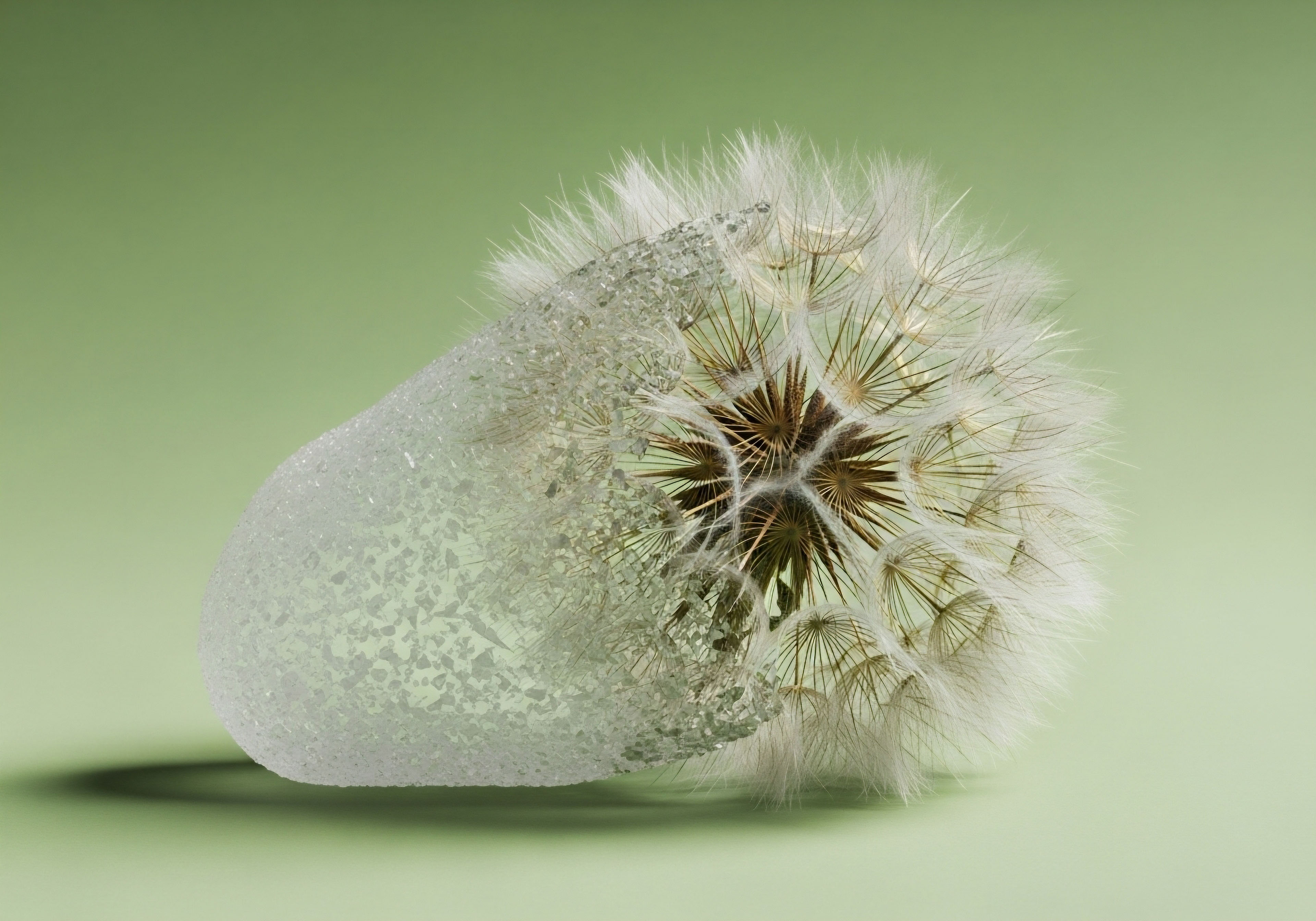

Fundamentals
Your body is a meticulously orchestrated system of communication. When you begin a protocol of testosterone replacement therapy (TRT), you are introducing a powerful signal to restore balance and vitality. You may have been told that this process involves quieting your body’s own internal hormone production.
This is a clinical reality of such a protocol, and understanding the mechanics behind it is the first step in managing your health with precision and confidence. Your symptoms, the fatigue, the mental fog, or the loss of strength, are valuable pieces of data. They are the language your body uses to report on its internal state. Our goal is to interpret this data and use targeted protocols to restore optimal function.
The core of this internal communication network is the Hypothalamic-Pituitary-Gonadal (HPG) axis. This is the biological pathway that governs your reproductive health and has profound influence over your metabolism, mood, and energy levels. It operates on a sophisticated feedback system.
The hypothalamus, a region in your brain, releases Gonadotropin-Releasing Hormone (GnRH) in carefully timed pulses. This GnRH travels a short distance to the pituitary gland, instructing it to release two other hormones ∞ Luteinizing Hormone (LH) and Follicle-Stimulating Hormone (FSH). These hormones then travel through your bloodstream to the testes, signaling them to produce testosterone and support sperm maturation.
When external testosterone is introduced, the brain’s own signals for hormone production are naturally suppressed.
When you administer exogenous testosterone, your brain detects that circulating levels are adequate. In response, the hypothalamus reduces or ceases its pulsatile release of GnRH. This is a natural, protective feedback mechanism. The pituitary, no longer receiving its instructions from the hypothalamus, stops releasing LH and FSH.
Consequently, the testes, deprived of their stimulating signals, reduce their own testosterone production and other functions. This state is known as HPG axis suppression. While necessary for the therapeutic effect of TRT, it leads to testicular atrophy and a shutdown of endogenous hormone synthesis. This is where Gonadorelin becomes a vital component of a comprehensive protocol.

The Communication Network of the HPG Axis
To visualize this system, think of the HPG axis as a command structure. The hypothalamus is the command center, the pituitary is the field commander, and the testes are the specialized units carrying out orders. In a balanced state, communication flows seamlessly.
During TRT, the communication from the top down is silenced because the desired outcome (adequate testosterone) is being achieved by an external source. The system goes dormant to conserve resources. Gonadorelin acts as a strategic intervention, designed to keep the lines of communication open between the field commander (pituitary) and the specialized units (testes), even while the main command center is quiet.
This table illustrates the functional state of the HPG axis under different conditions:
| Axis Component | Normal Physiological State | State During TRT (Unsupported) | State During TRT with Gonadorelin |
|---|---|---|---|
| Hypothalamus (GnRH) | Pulsatile release | Suppressed / Inactive | Suppressed / Inactive |
| Pituitary (LH & FSH) | Pulsatile release | Suppressed / Inactive | Pulsatile stimulation restored |
| Testes (Testosterone/Sperm) | Active production | Suppressed / Atrophy risk | Function maintained / Atrophy prevented |

What Is the Purpose of Maintaining Pituitary Dialogue?
Preserving the dialogue between the pituitary and the testes during TRT is a proactive strategy. It acknowledges that the body is a complex, interconnected system. The testes do more than produce testosterone; they are involved in a web of metabolic and reproductive processes.
By using Gonadorelin to maintain their function, the protocol aims to support the entire system, preventing the downstream consequences of complete gonadal shutdown. This approach provides the benefits of optimized testosterone levels while mitigating the suppressive effects of the therapy itself, creating a more sustainable and holistic physiological state.


Intermediate
Understanding that TRT suppresses the HPG axis, we can now examine the precise mechanism by which Gonadorelin restores a crucial part of that communication pathway. Gonadorelin is a synthetic peptide that is bioidentical to the natural Gonadotropin-Releasing Hormone (GnRH) produced by your hypothalamus. Its function is to directly engage the pituitary gland, effectively taking over the signaling role of the suppressed hypothalamus. It delivers the exact message the pituitary is designed to receive to initiate the release of gonadotropins.
The key to Gonadorelin’s effectiveness lies in its administration. The natural release of GnRH from the hypothalamus is not constant; it occurs in pulses. This pulsatile signaling is fundamental for maintaining the sensitivity of the pituitary’s GnRH receptors.
A continuous, unvarying signal would lead to receptor downregulation, where the pituitary cells become less responsive and eventually shut down production of LH and FSH. Therefore, Gonadorelin is administered intermittently, typically via subcutaneous injection two or more times per week, to mimic this natural rhythm. This approach ensures the gonadotroph cells in the pituitary remain responsive, preserving their ability to synthesize and secrete LH and FSH upon stimulation.
Gonadorelin works by mimicking the natural, pulsatile rhythm of the body’s own hormonal signals to the pituitary gland.

How Does Gonadorelin Differ from HCG?
In clinical practice, another agent sometimes used to maintain testicular function during TRT is Human Chorionic Gonadotropin (hCG). Understanding the distinction between Gonadorelin and hCG is critical for appreciating the targeted nature of modern hormonal optimization protocols. While both can prevent testicular atrophy, they operate at entirely different points in the HPG axis.
- Gonadorelin ∞ As a GnRH analog, it works “upstream.” It stimulates the pituitary gland itself, prompting a natural release of both LH and FSH. This action preserves the function of the pituitary gonadotrophs and results in a balanced, physiological stimulation of the testes.
- Human Chorionic Gonadotropin (hCG) ∞ This hormone works “downstream.” It mimics the action of Luteinizing Hormone (LH) directly at the testicular level. It bypasses the pituitary entirely and signals the Leydig cells in the testes to produce testosterone. While effective for this purpose, it does not stimulate the pituitary or induce FSH release.
The analogy of an electrical system is useful here. Using Gonadorelin is like flipping the light switch on the wall; it uses the existing wiring (the pituitary) to turn on the light (the testes). Using hCG is like bypassing the switch and connecting a battery directly to the light bulb. Both methods illuminate the room, but the former maintains the integrity of the entire circuit.

Comparing Upstream and Downstream Signaling Agents
The choice between these agents depends on the specific goals of the protocol. Gonadorelin is often selected for its more complete physiological action, preserving the function of two critical endocrine glands ∞ the pituitary and the testes.
| Feature | Gonadorelin | Human Chorionic Gonadotropin (hCG) |
|---|---|---|
| Primary Site of Action | Anterior Pituitary Gland | Testes (Leydig Cells) |
| Mechanism | Mimics GnRH, stimulates pituitary | Mimics LH, stimulates testes directly |
| Hormones Released by Body | Luteinizing Hormone (LH) and Follicle-Stimulating Hormone (FSH) | Primarily Testosterone and Estrogen from testes |
| Effect on Pituitary Function | Maintains or restores responsiveness | No effect; pituitary remains bypassed and suppressed |
| Physiological Parallel | Restores the hypothalamic-pituitary signal | Replaces the pituitary-gonadal signal |

Why Is Preserving FSH Release Significant?
The preservation of FSH release is a distinct advantage of using Gonadorelin. While LH is the primary driver of testosterone production from Leydig cells, FSH acts on the Sertoli cells within the testes. These cells are essential for spermatogenesis, or sperm production. By stimulating both hormonal pathways, Gonadorelin provides a more comprehensive maintenance of testicular function.
This is particularly relevant for individuals concerned about preserving fertility while on TRT. This dual-action approach supports the overall architecture and functional capacity of the gonads in a way that a single-pathway stimulus cannot fully replicate.


Academic
A sophisticated application of Testosterone Replacement Therapy requires a granular understanding of the neuroendocrine control of reproduction. The influence of Gonadorelin on pituitary function is a matter of precise molecular interaction within specialized cells known as gonadotrophs, located in the anterior pituitary. These cells express G-protein coupled receptors on their surface (GnRHR) that are specifically designed to bind with Gonadotropin-Releasing Hormone. When exogenous Gonadorelin is administered, it binds to these receptors, initiating a complex intracellular signaling cascade.
The binding of Gonadorelin to GnRHR activates the phospholipase C (PLC) pathway. PLC hydrolyzes a membrane phospholipid, phosphatidylinositol 4,5-bisphosphate (PIP2), into two secondary messengers ∞ inositol trisphosphate (IP3) and diacylglycerol (DAG). IP3 diffuses into the cytoplasm and binds to receptors on the endoplasmic reticulum, triggering a rapid release of stored calcium ions (Ca2+) into the cell.
This influx of intracellular calcium, along with the action of DAG activating protein kinase C (PKC), is the ultimate trigger for the synthesis and exocytosis (release) of vesicles containing Luteinizing Hormone and Follicle-Stimulating Hormone.
The frequency of the Gonadorelin pulse directly modulates the specific gonadotropin being released by the pituitary.

Differential Signaling and Pulse Frequency
The gonadotroph’s response is highly sensitive to the temporal pattern of GnRH stimulation. The frequency of GnRH (or Gonadorelin) pulses differentially regulates the synthesis and secretion of LH and FSH. This phenomenon is central to the physiological control of the reproductive cycle and is a key consideration in therapeutic protocols.
- High-Frequency Pulses ∞ Faster pulses (e.g. one pulse every 60-90 minutes) preferentially favor the synthesis and secretion of LH. This is the pattern that dominates during the late follicular phase of the menstrual cycle leading to ovulation, and it is the primary driver for testosterone production in males.
- Low-Frequency Pulses ∞ Slower pulses (e.g. one pulse every 2-3 hours) lead to a preferential synthesis and secretion of FSH. This allows for the development of ovarian follicles in females and supports spermatogenesis in males.
During TRT, the goal of Gonadorelin administration is not to perfectly replicate the complex endogenous rhythms but to provide a sufficient pulsatile stimulus to prevent pituitary desensitization and maintain the machinery for gonadotropin production. The typical twice-weekly injection schedule creates a significant pulse that effectively stimulates a release of both LH and FSH, thereby maintaining downstream testicular function. This prevents the deep suppression that would otherwise render the HPG axis unresponsive over long periods.

What Is the Clinical Significance of Preventing Gonadotroph Desensitization?
Preventing the desensitization of gonadotroph cells is a forward-thinking clinical strategy. Long-term, unstimulated suppression of the HPG axis can make future restoration of function more challenging if TRT is ever discontinued. By keeping the pituitary-gonadal link active with Gonadorelin, the system remains primed and responsive.
This can be conceptualized as maintaining metabolic fitness at a cellular level. The gonadotrophs retain their capacity to respond to stimuli, and the testes retain their capacity to respond to gonadotropins. This preserved functionality provides greater flexibility for long-term health management and potential future fertility goals. The use of Gonadorelin within a TRT protocol is therefore a measure that supports both immediate well-being and long-term physiological resilience.

Implications for Systemic Endocrine Health
The HPG axis does not operate in isolation. It is intricately linked with other endocrine systems, including the Hypothalamic-Pituitary-Adrenal (HPA) axis, which regulates the stress response. Dysregulation in one axis can influence another. By maintaining a more physiological state within the HPG axis during TRT through the use of Gonadorelin, the protocol may support broader endocrine homeostasis.
The testes produce hormones other than testosterone, and maintaining their function supports a more complete hormonal milieu. This systems-biology perspective acknowledges that treating one part of a network has effects throughout the system, and interventions should aim to preserve as much natural function as possible.

References
- Belchetz, Paul E. et al. “Hypophysial responses to continuous and intermittent delivery of gonadotrophin-releasing hormone.” Science, vol. 202, no. 4368, 1978, pp. 631-33.
- Jacobson, Mark H. et al. “A randomized, placebo-controlled trial of testosterone replacement in young and older men with opioid-induced androgen deficiency.” The Journal of Clinical Endocrinology & Metabolism, vol. 101, no. 8, 2016, pp. 2988-97.
- Tsutsumi, Rie, and Webster, Neil J.G. “GnRH Pulsatility, the Pituitary Response and Reproductive Dysfunction.” Endocrine Journal, vol. 56, no. 6, 2009, pp. 729-37.
- Rastrelli, Giulia, et al. “Testosterone Replacement Therapy.” Sexual Medicine Reviews, vol. 7, no. 3, 2019, pp. 464-75.
- Anaissie, James, et al. “A trigger a day keeps the shutdown away ∞ A case of intermittent-use of low-dose gonadotropin-releasing hormone agonist to prevent and treat iatrogenic hypogonadism.” Case Reports in Urology, vol. 2018, 2018, Article 6495048.
- Bhasin, Shalender, et al. “Testosterone therapy in men with hypogonadism ∞ an Endocrine Society clinical practice guideline.” The Journal of Clinical Endocrinology & Metabolism, vol. 103, no. 5, 2018, pp. 1715-44.
- Liu, P. Y. et al. “The half-life of biological activity of luteinizing hormone is longer than the half-life of its immunoreactivity.” The Journal of Clinical Endocrinology & Metabolism, vol. 88, no. 8, 2003, pp. 3821-27.
- Handelsman, David J. “Androgen physiology, pharmacology, and abuse.” Endotext, edited by Kenneth R. Feingold et al. MDText.com, Inc. 2000.
- Crowley, William F. et al. “The physiology of gonadotropin-releasing hormone (GnRH) secretion in men and women.” Recent Progress in Hormone Research, vol. 41, 1985, pp. 473-531.
- Whitcomb, Roger W. et al. “Differential regulation of Luteinizing Hormone and Follicle-Stimulating Hormone secretion by Gonadotropin-Releasing Hormone pulse frequency in men.” The Journal of Clinical Endocrinology & Metabolism, vol. 70, no. 3, 1990, pp. 645-51.

Reflection

Charting Your Biological Course
The information presented here provides a map of a specific biological territory. It details the signals, the pathways, and the cellular responses that define a part of your internal world. This knowledge is a tool. It allows you to understand the logic behind your clinical protocol and to appreciate the intricate systems that support your vitality. Your health is a dynamic process, a continuous dialogue between your body, your choices, and the targeted support you implement.
Consider the data your own body provides you daily through your sense of well-being, your energy, and your physical function. How does understanding these mechanisms change the way you interpret that data? The objective of any personalized wellness protocol is to move beyond passive treatment and toward active, informed management of your own physiology. This understanding is the foundation upon which you can build a sustainable strategy for long-term function and resilience.



